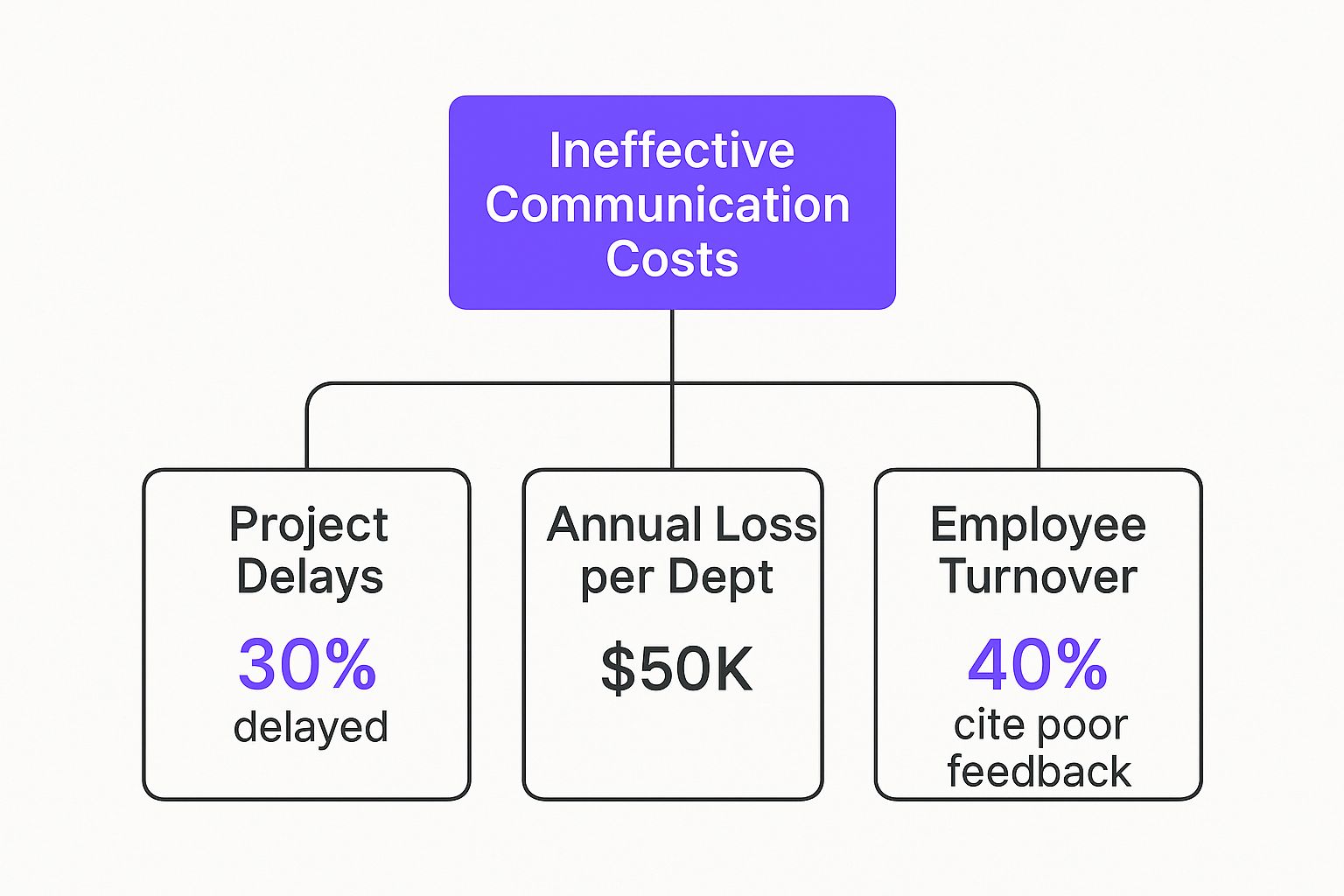Master Business Communication Skills Training

Business communication skills training is simply the process of getting better at core skills—like active listening, clarity, and empathy—to improve how your teams talk to each other, work together, and hit their goals. It's about intentionally turning disjointed conversations into a powerful tool for success.
Why Business Communication Training Is a Non-Negotiable Asset

Think of your company as an orchestra. You might have brilliant musicians on every instrument, but without a conductor to provide clear direction, you just get noise. A symphony? Not a chance.
Structured business communication training acts as that conductor. It aligns everyone’s individual efforts to create something harmonious and productive, transforming messy interactions into a force for getting things done.
When teams are stuck operating on assumptions and vague messages, projects grind to a halt, conflicts pop up, and morale takes a nosedive. This kind of training moves everyone past the guesswork by creating a shared language and set of practices for good dialogue.
The Growing Demand for Stronger Skills
The global recognition of these skills is impossible to ignore. The market for soft skills training, which includes communication, was valued at USD 33.4 billion in 2024. It’s projected to nearly triple to USD 92.6 billion by 2033.
That's a massive surge. It shows just how much employers now see communication and emotional intelligence as absolutely vital for success. You can discover more market growth insights from GlobeNewswire.
From Good Idea to Essential Investment
Investing in how your team communicates isn't just a 'nice-to-have'—it’s a strategic move that delivers real, tangible business results. Well-trained teams are simply better equipped to:
- Navigate complex projects with fewer mix-ups and costly redos.
- Build stronger client relationships through interactions that are clear, empathetic, and professional.
- Resolve internal conflicts constructively, which helps foster a more positive and supportive culture.
"If your managers and staff can’t communicate with each other, not to mention with your customers, your partners and your stakeholders, you’re likely to fail. It’s as simple and important as that."
Ultimately, solid communication is the bedrock of every successful professional relationship. When you prioritize these skills, you're empowering your people to connect and collaborate in more meaningful ways. Want to dig deeper? Check out our guide on https://blog.makerbox.io/how-to-build-professional-relationships/.
In fact, developing strong communication is often what separates a good career from a great one. You can find more practical tips for improving workplace communication skills.
The Hidden Costs of Ineffective Team Communication
Poor communication is so much more than an occasional annoyance. It's a silent drain on your company’s resources, chipping away at profitability and morale day by day.
Think of it like a slow leak in a tire. It might not cause an immediate blowout, but over time, it deflates performance, slows progress, and eventually brings everything to a standstill.
These costs aren't just abstract ideas—they have real, tangible impacts. A vague email chain can easily lead to a critical project detail being missed, causing days of rework. In the same vein, a talented employee might quit after months of receiving unclear feedback, leaving your team to shoulder the cost of recruiting and training a replacement.
The infographic below visualizes this domino effect, showing how small communication breakdowns translate into project delays, financial losses, and employee turnover.

As the data shows, these aren't minor hiccups. They are significant drags on your company's health that hit the bottom line directly.
The Financial and Cultural Damage
The financial bleeding caused by poor communication is staggering. In the United States alone, businesses lose an estimated $1.2 trillion every year from lost productivity and avoidable errors. What's more, a whopping 86% of employees point to ineffective communication as the main reason their teams fail to hit their goals. You can read the full research on communication's financial impact to see the sheer scale of the problem.
Beyond the balance sheet, the cultural damage is just as severe. When communication fails, it erodes the very foundation of a healthy workplace.
- Declining Morale: Constant misunderstandings and a lack of clarity leave employees feeling frustrated, undervalued, and completely disengaged.
- Stalled Innovation: Great ideas get lost in translation or are never shared in the first place because team members don't feel psychologically safe enough to speak up.
- Eroding Trust: A lack of transparency from leadership can quickly break the trust that’s essential for a cohesive team. This is a critical point we explore in our guide on how to build trust with customers, as the principles are nearly identical.
Investing in business communication skills training isn't an expense; it's a strategic defense against the hidden costs that silently undermine your success. It plugs the leaks, reinforces your team's foundation, and ensures everyone is moving forward together, efficiently and effectively.
Core Skills Covered in High-Impact Communication Training

Truly effective communication training is so much more than just a list of tips like "be a better listener." It's about breaking down communication into its core skills and giving you practical, actionable techniques for each one. Think of it less like a lecture and more like a hands-on workshop where you build a versatile toolkit for any situation.
A high-impact program doesn't just tell you what to do; it shows you how. You get the frameworks and the practice needed to turn theory into a natural, confident skill. It's the difference between knowing you should communicate clearly and actually being able to do it under pressure.
These programs typically focus on four foundational pillars. When you get these right, it creates a ripple effect, improving everything from team collaboration and client relationships to your own leadership presence.
Active Listening: Hearing What Isn’t Said
Most of us think of listening as passive—just waiting for our turn to talk. But active listening is a completely different game. It's a dynamic process of engagement, about hearing not just the words but the intent, emotion, and unspoken needs behind them.
Imagine a client says, "The project is fine, but we're a bit concerned about the timeline." A passive listener hears a simple status update. An active listener, on the other hand, picks up on the hesitation and understands the real message: "We're losing confidence and need some reassurance."
Active listening is the bedrock of interpersonal communication. It's the skill that allows you to read between the lines, build genuine trust, and identify the real problems that need solving.
A quality training program teaches you how to:
- Paraphrase and clarify to make sure you've understood correctly, nipping misunderstandings in the bud.
- Ask insightful questions that encourage the other person to open up and feel truly heard.
- Pay attention to tone and body language to catch the emotional subtext that words alone miss.
Clarity and Concision: Getting to the Point
In business, time is everyone's most finite resource. A message that rambles, is vague, or is packed with jargon wastes time and creates confusion. The ability to be clear and concise isn't just a skill—it's a superpower.
This is all about trimming the fat from your communication. It’s like becoming an expert editor for your own thoughts, ensuring every word serves a purpose. Instead of a long, meandering email that buries the main point, you learn to lead with the key takeaway and back it up with only the essential details.
Effective training provides you with mental models for structuring your thoughts, whether you're speaking up in a meeting or drafting an important update.
Reading Non-Verbal Cues: The Silent Language
So much of communication is non-verbal. A crossed arm, a slight frown, or a lack of eye contact can speak volumes, often contradicting what's being said. If you ignore these signals, you're only getting half the message.
Good communication training sharpens your ability to interpret this silent language. It also makes you more aware of your own non-verbal signals and how they impact your credibility. This awareness is absolutely crucial for navigating negotiations, leading team meetings, and building rapport.
Mastering Written Communication: Words that Work
From emails to project proposals, written communication is the lifeblood of most organizations. A poorly written message can lead to costly errors, damage professional relationships, and undermine your authority. That's why high-impact training focuses on creating written content that is not just correct, but compelling.
This is about more than just grammar; it's about structuring your documents for maximum readability and impact. For a deeper dive into this area, you can explore these powerful business writing tips.
To put it all together, here’s a quick look at how these core competencies translate into real-world workplace impact.
Table: Key Business Communication Competencies
| Competency | Core Elements | Impact in the Workplace |
|---|---|---|
| Active Listening | Paraphrasing, asking clarifying questions, reading emotional cues. | Builds trust, reduces misunderstandings, and uncovers underlying client or team needs. |
| Clarity & Concision | Structuring thoughts logically, avoiding jargon, getting to the point. | Saves time, prevents confusion, and ensures key messages are received and understood. |
| Non-Verbal Cues | Interpreting body language, tone of voice, and facial expressions. | Improves negotiation outcomes, enhances leadership presence, and builds stronger rapport. |
| Written Communication | Clear structuring, persuasive language, proper tone and grammar. | Increases professional credibility, reduces errors, and drives action through clear proposals and reports. |
Mastering these skills gives professionals a distinct advantage, turning routine interactions into opportunities for connection, influence, and success.
Proven Frameworks for Clear and Persuasive Communication
Knowing the core communication skills is one thing; applying them effectively under pressure is a completely different ballgame. This is where proven frameworks come in—think of them as recipes for clear, persuasive conversations.
Instead of fumbling for the right words or starting from scratch every time you need to give feedback or handle an urgent issue, you can lean on these reliable structures. They give you a clear path to follow, helping you organize your thoughts and deliver your message with confidence.
Adopting these frameworks is a huge part of effective business communication skills training because it turns abstract ideas into practical, repeatable actions.
The STAR Method for Compelling Updates
The STAR method (Situation, Task, Action, Result) is a storytelling framework that's perfect for performance reviews, project updates, and job interviews. It helps you ground your accomplishments in a clear, logical narrative that people can actually follow.
- Situation: Briefly set the scene. What was the context?
- Task: What was the specific goal or challenge you were up against?
- Action: Detail the concrete steps you took to tackle the task.
- Result: Explain the outcome. What was the positive impact of what you did?
For example, in a performance review, you could say: "Last quarter (Situation), our team’s lead generation was down by 15%. My Task was to figure out why and fix the leak in our marketing funnel. I analyzed our analytics, rewrote our ad copy, and A/B tested new landing pages (Action). As a Result, we boosted qualified leads by 22% and crushed our quarterly goal."
The SBAR Model for Urgent Conversations
When things get urgent and there's zero room for confusion, the SBAR model (Situation, Background, Assessment, Recommendation) is your best friend. It was originally created for high-stakes medical situations, so you know it’s designed to get critical information across quickly and accurately.
It works by structuring the conversation to eliminate any guesswork and drive a clear decision. It's incredibly useful for escalating a problem to a manager or briefing a team on a sudden change of plans.
The SBAR model cuts through the noise. It forces you to present a concise, logical case for action, making it far easier for the listener to grasp the issue and make an informed decision without delay.
Here’s how it breaks down:
- Situation: A one-sentence summary of the immediate problem. ("The main server for our e-commerce site is down.")
- Background: Relevant, concise context. ("It went offline ten minutes ago during peak shopping hours. We're losing sales by the minute.")
- Assessment: Your professional conclusion. ("I believe this is a hardware failure, not a software bug. A simple reboot didn't work.")
- Recommendation: What you think should happen next. ("I recommend we authorize the emergency vendor support call, which costs $500.")
By using frameworks like STAR and SBAR, you remove the guesswork from important conversations. They provide a reliable structure that ensures your message is not just heard, but also understood and acted upon. These methods are also fundamental for crafting a compelling narrative, a skill explored in our guide on creating powerful elevator pitch examples.
How to Implement an Effective Communication Training Program

Putting together a communication skills program that actually works is about more than just booking a webinar and hoping for the best. It's a strategic move. The goal is to build a roadmap that targets specific needs, uses modern delivery methods, and grows with your employees through every stage of their career.
You need a program that feels relevant, practical, and genuinely impactful for every single person who participates. A one-size-fits-all approach is a recipe for wasted time and money.
Think about it: a new hire needs the fundamentals of professional email etiquette, while a senior leader needs to master conflict mediation and executive presence. Great training recognizes these differences and tailors the content so it hits home. It’s time to move beyond generic modules and create something that solves your team's real, everyday challenges.
Choose the Right Delivery Methods
How you teach is just as important as what you teach. The best results usually come from a blended learning approach, mixing different formats to keep people engaged and respect their packed schedules.
Consider a mix of these powerful methods:
- Interactive Workshops: These are perfect for hands-on practice. Think role-playing difficult conversations or getting immediate, in-person feedback.
- Scalable E-learning Modules: This is all about flexibility. E-learning lets employees master foundational concepts on their own time, at their own pace.
- AI-Powered Feedback Tools: Modern platforms can analyze speech patterns or written messages, giving people instant, private feedback to help them fine-tune their communication.
This kind of multifaceted strategy makes sure that learning isn’t just a one-off event. It becomes a continuous cycle of skill development.
Tailor Content for Every Career Level
To really make an impact, your training has to evolve with your people. Segmenting your program makes the skills you’re teaching immediately useful in each person's role.
- For New Hires: Stick to the fundamentals. We’re talking about clear written communication, active listening in meetings, and knowing which channel to use for what.
- For Mid-Level Managers: The focus should shift to delegation, giving constructive feedback that helps people grow, and running team meetings that are actually productive.
- For Senior Leaders: The curriculum here is more advanced. Think crisis communication, using persuasive storytelling with stakeholders, and navigating complex negotiations.
This targeted approach makes the training far more valuable and radically increases the chances that the new skills will actually get used. The whole point is creating a training programme that actually works and delivers real improvement. To figure out what that improvement looks like, it’s worth exploring frameworks like the Kirkpatrick levels of evaluation.
Address the Challenges of Hybrid Work
In today's world of distributed teams, being a pro at digital communication is non-negotiable. Your program has to tackle the unique challenges that come with remote and hybrid work. This is a big deal for recruiters, too—55% of them globally say verbal communication is the top skill they look for, followed by presentation skills (47%) and active listening (36%).
Crucially, 36% also point to proficiency with digital collaboration tools as essential.
A truly effective program must have dedicated modules on video conference etiquette, how to write clear asynchronous messages, and techniques for building rapport with colleagues you might only see on a screen.
By building a thoughtful, multi-layered program, you’re not just training individuals. You’re building a sustainable culture of clear communication that strengthens your entire organization from the inside out.
Got Questions About Communication Training? We've Got Answers.
Even when leaders are sold on the benefits, a few practical questions always pop up before they invest in business communication skills training. Let's clear up those common hurdles right now so you can move forward with confidence, knowing you’re making a smart choice for your team and your bottom line.
Think of this as the straight-talk section. We're tackling the most frequent questions we hear from leaders to get you the actionable answers you need.
How Can We Measure the ROI of Communication Training?
Figuring out the return on investment for communication training is less abstract than you might think. It’s all about tracking the right numbers and listening to your team to see the full picture.
On the quantitative side, you can connect the dots between training and your key performance indicators (KPIs). Look for movement in areas like:
- Project Completion Rates: Are projects suddenly hitting deadlines more often? When instructions are clear and misunderstandings drop, delays naturally shrink.
- Fewer Errors: Start tracking how often work needs to be redone. A 15% drop in project revisions after training, for instance, isn't just a win—it's a direct cost saving.
- Team Productivity: Great communication cuts down on the time wasted asking for clarification. That's more time spent on the work that actually matters.
Then, add the human element. Use simple pre- and post-training surveys to measure changes in team morale, employee engagement, and how confident people feel. When you combine that feedback with hard performance data, you build an undeniable case for the training’s impact.
What Is the Most Important Communication Skill for Leaders?
If you had to pick just one, it would be active listening. Hands down. It's the skill that underpins everything else a leader does.
Great leaders don't just talk; they listen. They absorb what their team is really saying, dig into challenges, and create an environment where people feel safe enough to give honest feedback.
When employees feel genuinely heard, they become more engaged, innovative, and committed. By mastering active listening, a leader can prevent conflicts, foster trust, and make better-informed decisions.
It’s the foundation all other leadership skills are built on. Active listening is the difference between simply directing a team and truly empowering one.
How Do We Adapt Training for Remote and Hybrid Teams?
For teams that are spread out, training has to get specific about digital communication. You can't just talk about general principles; you need to focus on the tools and etiquette of working in a remote or hybrid world.
Your program should have modules dedicated to the new realities of work:
- Mastering the Video Call: This goes beyond just muting your mic. It’s about learning how to keep people engaged, manage your digital presence, and run virtual meetings that don't drain everyone's energy.
- Writing for a Digital World: Teach your team how to be clear and concise in emails, chat platforms like Slack, and project management tools. Action-oriented writing is key.
- Smart Collaboration: Make sure everyone knows how to use shared documents and platforms effectively. The goal is to keep work flowing smoothly without needing a meeting for everything.
A blended approach is your best bet here. Mix self-paced online courses that people can do on their own schedule with live virtual workshops. The workshops are perfect for interactive role-playing and getting direct, real-time feedback. This makes the training accessible and ensures it tackles the real-world challenges your team faces every day.
Ready to stop communication breakdowns and build a more connected, efficient team? MakerBox offers AI-driven tools to help professionals craft clear, compelling messages that get results. Elevate your team's online presence and communication skills by visiting https://www.makerbox.io.





